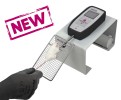Authors
Mihailovska E, Raith M, Valencia RG, Fischer I, Al Banchaabouchi M, Herbst R, Wiche G
Lab
Department of Biochemistry and Cell Biology, Max F. Perutz Laboratories, University of Vienna, Vienna, Austria
Journal
Mol Biol Cell.
Abstract
Mutations in the cytolinker protein plectin lead to grossly distorted morphology of neuromuscular junctions (NMJs) in patients suffering from epidermolysis bullosa simplex (EBS)-muscular dystrophy (MS) with myasthenic syndrome (MyS). Here we investigated whether plectin contributes to the structural integrity of NMJs by linking them to the postsynaptic intermediate filament (IF) network. Live imaging of acetylcholine receptors (AChRs) in cultured myotubes differentiated ex vivo from immortalized plectin-deficient myoblasts revealed them to be highly mobile and unable to coalesce into stable clusters, in contrast to wild-type cells. We found plectin isoform 1f (P1f) to bridge AChRs and IFs via direct interaction with the AChR-scaffolding protein rapsyn in an isoform-specific manner; forced expression of P1f in plectin-deficient cells rescued both compromised AChR clustering and IF network anchoring. In conditional plectin knockout mice with gene disruption in muscle precursor/satellite cells (Pax7-Cre/cKO), uncoupling of AChRs from IFs was shown to lead to loss of postsynaptic membrane infoldings and disorganization of the NMJ microenvironment, including its invasion by microtubules. In their phenotypic behavior, mutant mice closely mimicked EBS-MD-MyS patients, including impaired body balance, severe muscle weakness, and reduced life span. Our study demonstrates that linkage to desmin IF networks via plectin is crucial for formation and maintenance of AChR clusters, postsynaptic NMJ organization, and body locomotion.
BIOSEB Instruments Used:
Grip strength test (BIO-GS3)

 Pain - Thermal Allodynia / Hyperalgesia
Pain - Thermal Allodynia / Hyperalgesia Pain - Spontaneous Pain - Postural Deficit
Pain - Spontaneous Pain - Postural Deficit Pain - Mechanical Allodynia / Hyperalgesia
Pain - Mechanical Allodynia / Hyperalgesia Learning/Memory - Attention - Addiction
Learning/Memory - Attention - Addiction Physiology & Respiratory Research
Physiology & Respiratory Research
 Pain
Pain Metabolism
Metabolism Motor control
Motor control Neurodegeneration
Neurodegeneration Cross-disciplinary subjects
Cross-disciplinary subjects Muscular system
Muscular system General activity
General activity Mood Disorders
Mood Disorders Other disorders
Other disorders Joints
Joints Central Nervous System (CNS)
Central Nervous System (CNS) Sensory system
Sensory system
